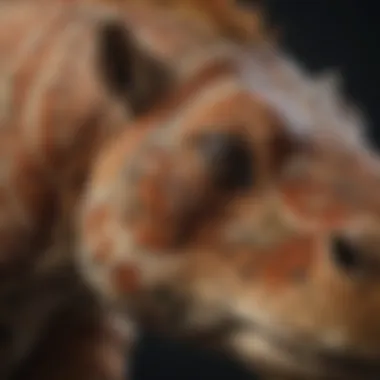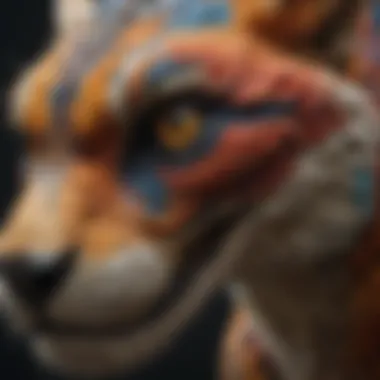Unveiling the Enigmatic World of Fascinating Extinct Creatures


Rock and Fossil Identification
Fossil identification is a captivating endeavor that allows enthusiasts to unlock the secrets of the past through ancient remnants found in rocks. Several types of rocks and fossils exist, each with distinct characteristics that aid in their identification. Sedimentary rocks commonly house fossils, with limestones preserving marine life and shales bearing plant fossils. When identifying fossils, enthusiasts should look for specific traits like texture, color, and shape, as these can provide clues to the organism's original form and habitat. Various tools such as magnifying glasses, chisels, and brushes are instrumental in delicately uncovering and examining fossils without causing damage.
Collecting Tips and Techniques
For aspiring collectors, understanding the best practices of collecting fossils is paramount to preserving these ancient treasures. Locating prime collecting sites involves research into geological maps to pinpoint areas rich in fossil deposits. Once a suitable site is located, collectors must adhere to ethical guidelines and laws governing fossil collection to ensure the preservation of these valuable artifacts for future study. When extracting specimens, it is essential to use proper tools like rock hammers and brushes to carefully remove surrounding debris without harming the fossil. Safety measures should always be prioritized during extraction to prevent accidents and preserve the integrity of the specimen.
Preservation and Display
Preservation techniques play a crucial role in maintaining the integrity of fossils for prolonged study and enjoyment. Methods such as stabilizing fragile fossils with consolidants and protective coatings help prevent deterioration over time. Proper storage in controlled environments with optimal temperature and humidity levels is essential to prevent mold growth and mineral degradation. When it comes to displaying fossils, creativity can flourish, with various ideas ranging from minimalist stands to elaborate shadow boxes enhancing the aesthetic appeal of the specimens, making them a focal point of admiration and education.
Geological Insights
Introduction
Understanding Extinction
The Process of Extinction
The process of extinction, a key facet of the natural world, involves the disappearance of a species either locally or globally. It plays a significant role in shaping ecosystems and species diversity. Understanding the mechanisms behind extinction helps researchers comprehend the dynamics of biodiversity loss over time. By examining the factors contributing to extinction events, scientists can glean valuable information on the consequences of environmental changes and human interventions.


Impact of Environmental Changes
Environmental changes, such as climate shifts and habitat destruction, exert profound influences on species survival. These alterations can disrupt ecosystems, leading to shifts in population dynamics and species interactions. The impact of environment on extinctions underscores the delicate balance between organisms and their surroundings. By studying how environmental changes drive extinctions, researchers can enhance conservation efforts and mitigate future biodiversity loss.
Fascination with Extinct Animals
Appeal to Researchers and Enthusiasts
The allure of extinct animals transcends mere curiosity, captivating both researchers and enthusiasts worldwide. The study of these creatures provides valuable insights into past environments and the evolutionary trajectories of life on Earth. Researchers are drawn to the puzzles presented by extinct species, unraveling their unique adaptations and ecological roles. Enthusiasts, on the other hand, revel in the mystique surrounding these ancient beasts, fueling a passion for paleontology and natural history.
Unraveling the Enigma
In this section of the article, we delve into the crucial aspect of unraveling the enigma surrounding crazy extinct animals. By exploring the peculiar traits and unusual adaptations of these creatures, we aim to shed light on their significance in understanding prehistoric life. Unraveling the enigma is essential as it provides valuable insights into the evolutionary mysteries and unique features of these extinct animals. By analyzing their colossal beasts and bizarre creatures, we can comprehend the impact of environmental changes and the adaptations that allowed these creatures to thrive in a bygone era. Through unraveling the enigma of crazy extinct animals, we enhance our knowledge of the diversity and complexity of prehistoric organisms, sparking curiosity and fascination among enthusiasts and researchers alike.
Bizarre Creatures
The peculiar traits of extinct animals:
The peculiar traits of extinct animals offer a gateway to understanding the unconventional characteristics that defined these prehistoric beings. From the oversized teeth of the Megalodon to the saber-like tusks of the Woolly Mammoth, each feature served a specific evolutionary purpose. These peculiar traits give us remarkable insights into the adaptive strategies of ancient creatures, showcasing nature's creativity and diversity in sculpting life forms. By unraveling the peculiar traits of extinct animals, we unlock the mysteries of their morphology and behavior, paving the way for a deeper appreciation of evolutionary biology.
Unusual adaptations:
Unusual adaptations in extinct animals highlight the remarkable ways in which organisms evolve to survive changing environments. From the elongated neck of the Brachiosaurus to the armor-plated skin of the Ankylosaurus, these adaptations showcase the incredible diversity of life forms that once roamed the Earth. By examining the unusual adaptations of extinct animals, we gain valuable insights into the evolutionary pressures that shaped their bodies and behaviors. These adaptations not only demonstrate the sophistication of ancient life forms but also provide crucial information for understanding today's ecological challenges.


Massive Beasts
Gigantic proportions of extinct animals:
The gigantic proportions of extinct animals represent a key aspect of prehistoric life that continues to captivate our imaginations. From the towering height of the Sauroposeidon to the immense weight of the Indricotherium, these massive beasts defy conventional size expectations. By exploring the gigantism displayed by these creatures, we confront the sheer scale of biodiversity that once existed on our planet. The colossal dimensions of these extinct animals not only showcase the ingenuity of evolution but also raise questions about the ecological dynamics that governed their existence. Studying the gigantic proportions of extinct animals offers a window into a world where size truly mattered and where nature's grandeur knew no bounds.
Exploration of Diversity
In this section of the article, we delve into the critical aspect of exploring the diverse range of extinct animals, highlighting the importance of understanding the sheer variety that once populated our planet. By dissecting prehistoric oddities, we uncover unique features and evolutionary mysteries that contribute significantly to our overall comprehension of extinct species. This exploration sheds light on the intriguing adaptations and anomalies present in the animal kingdom of the past, offering valuable insights into the complexities of ancient life forms.
Prehistoric Oddities
Unique features of extinct animals
When examining the unique features of extinct animals, we focus on distinct characteristics that set these creatures apart from their modern counterparts. These features, ranging from oversized horns to peculiar anatomical structures, provide a window into the evolutionary path these animals followed. By exploring these distinctive traits, we gain a profound understanding of how prehistoric creatures survived and interacted within their ecosystems, enriching our knowledge of ancient biodiversity.
Evolutionary mysteries
The enigma of evolutionary mysteries surrounding extinct animals captures our imagination and fuels scientific inquiry into the mechanisms of evolution. From sudden disappearances to perplexing adaptations, these mysteries challenge our understanding of natural selection and species survival. By unraveling these complexities, we uncover hidden narratives of extinction events and evolutionary divergence, offering tantalizing glimpses into the distant past and the forces that shaped Earth's biosphere.
Lost Species


In the realm of lost species, we encounter a myriad of extinct animals that illustrate the vast diversity of prehistoric life forms. Each species represents a unique thread in the tapestry of biological evolution, showcasing the endless variations that once thrived on our planet. By highlighting the range of extinct animals, we underscore the intricate web of life that characterized ancient ecosystems, painting a vivid picture of the rich biodiversity that has since vanished from the Earth's surface.
Illustrating the variety of extinct animals
When illustrating the variety of extinct animals, we showcase the array of forms, sizes, and adaptations that defined prehistoric fauna. From microscopic organisms to colossal mega-fauna, each species adds a layer of complexity to our understanding of ecological dynamics and evolutionary change. By examining this diversity, we gain valuable insights into the staggering array of life that once inhabited Earth's continents and seas, underscoring the intricate balance of nature that shaped our planet's history.
Legacy of Extinct Animals
In this segment, we delve into the profound significance of the legacy of extinct animals. The remnants left behind by these creatures offer a unique window into the past, shedding light on the intricate web of interactions that once shaped our ecosystems. By examining the legacy of extinct animals, we can glean valuable insights into the dynamics of ancient environments, drawing parallels to the current state of our planet. This exploration is crucial for understanding the implications of past extinctions and their ripple effects on the present biodiversity.
Impact on Ecosystems
Ecosystem Dynamics Post-Extinction
The aftermath of extinction events reverberates throughout ecosystems, triggering intricate changes in the delicate balance of nature. Post-extinction, ecosystems undergo a period of recalibration as they adapt to the sudden void left by the vanished species. This period of flux often catalyzes the rise of new ecological niches, driving the evolution of surviving organisms to fill the vacated roles. Ecosystem dynamics post-extinction act as a natural experiment, illuminating the resilience and vulnerability of different species in the face of environmental disturbances. By dissecting these dynamics, we uncover the mechanisms that govern ecosystem stability and resilience, offering crucial insights for conservation strategies and proactive biodiversity management.
Scientific Insights
Unraveling the mysteries of evolution lies at the core of scientific inquiries into extinct animals. The contributions of extinct creatures to evolutionary studies are immeasurable, providing pivotal clues to the mechanisms of adaptation and speciation. Studying the fossil records and genetic remnants of extinct species unveils the intricate processes that have shaped life on Earth over millions of years. By scrutinizing these scientific insights, researchers can refine evolutionary models, reconstruct past ecosystems, and forecast the potential trajectories of current biodiversity trends. The revelations garnered from these studies not only enrich our understanding of the past but also equip us with the knowledge to navigate the complex challenges of conservation and preservation in the Anthropocene epoch.
Conclusion
Exploring the legacy of extinct animals is crucial in understanding the dynamics of ecosystems and gaining valuable insights into evolutionary studies. The impact of these creatures on the environment post-extinction sheds light on ecosystem resilience and adaptation. Moreover, the scientific community benefits greatly from the study of extinct animals, as it provides a basis for evolutionary research and enhances our knowledge of the natural world.
Reflection on Extinct Animals
Continued fascination with prehistoric creatures
The ongoing allure of prehistoric creatures plays a significant role in driving interest and research within the field of paleontology. The fascination with these ancient beings stems from their uniqueness and capacity to spark curiosity among enthusiasts and researchers alike. By continuing to study and explore the remnants of extinct animals, we uncover invaluable information about past life forms, contributing to a better understanding of the earth's evolutionary history and biodiversity.







